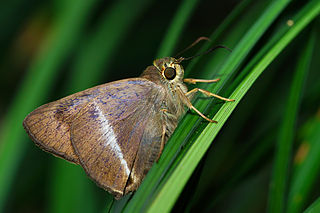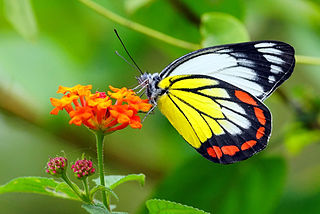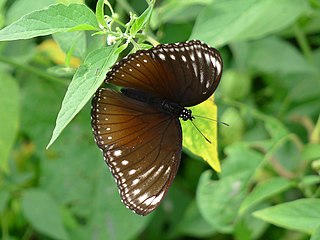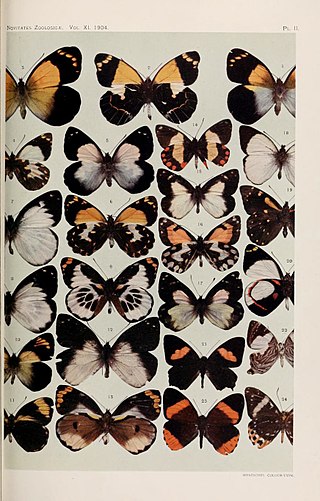
Papilio polytes, the common Mormon, is a common species of swallowtail butterfly widely distributed across Asia.

Hasora taminatus, the white banded awl, is a butterfly belonging to the family Hesperiidae, which is found in Asia.

Hypolimnas bolina, the great eggfly, common eggfly, varied eggfly, or in New Zealand the blue moon butterfly, is a species of nymphalid butterfly found from Madagascar to Asia and Australia.

Hebomoia glaucippe, the great orange-tip, is a butterfly belonging to the family Pieridae, that is the yellows and whites. It is found in the Indomalayan realm and Wallacea.

Delias hyparete, the painted Jezebel, is a medium-sized butterfly of the family Pieridae, found in South Asia and Southeast Asia.

Miletus symethus, the great brownie, is a small butterfly found in India that belongs to the lycaenids or blues family. The species was first described by Pieter Cramer in 1777.

Delias is a genus of butterflies. There are about 250 species of the genus Delias, found in South Asia and Australia. The genus is considered to have its evolutionary origins in the Australian region.

Hypolycaena erylus, the common tit, is a small but striking butterfly found in India and South-East Asia that belongs to the lycaenids or blues family. The species was first described by Jean-Baptiste Godart in 1823.

Arhopala eumolphus, the green oakblue, is a lycaenid butterfly found in the Indomalayan realm. The species was first described by Pieter Cramer in 1780.

Deudorix epijarbas, the cornelian or hairy line blue, is a species of lycaenid or blue butterfly found in south and southeast Asia from India to Fiji, including the Philippines, and also the tropical coast of Queensland in Australia. The species was first described by Frederic Moore in 1857.

Arhopala anthelus, the angelus bush blue, is a species of lycaenid or blue butterfly found in the Indomalayan realm.

Iraota rochana, the scarce silverstreak, is a species of lycaenid or blue butterfly with several subspecies found in Manipur, Myanmar, Java, Borneo, Sumatra, Malaya, Langkawi, Thailand, Singapore, Sulawesi and the Philippines. The species was first described by Thomas Horsfield in 1829.

Cepora judith, the Orange Gull, is a butterfly of the family Pieridae. It has no common name, although a subspecies is referred to as the orange gull. It is found in south-eastern Asia.

Eurema simulatrix, the changeable grass yellow, is a butterfly in the family Pieridae. It is found from Burma to Sundaland, Cambodia and the Philippines. The habitat consists of secondary or disturbed habitats including forest clearings, roadsides and riverbanks, parks and gardens.

Hypolimnas anomala, commonly known as the Malayan eggfly or crow eggfly, is a species of eggfly.

Jamides cyta, the pale cerulean, is a butterfly of the lycaenids or blues family. It is found throughout South-east Asia, from Malaysia to the Solomon Islands and the Philippines, as well as Queensland in Australia.

Delias ninus, the Malayan Jezebel, is a butterfly in the family Pieridae. It was described by Alfred Russel Wallace in 1867. It is found in the Indomalayan realm.

Delias sagessa is a butterfly in the family Pieridae. It was described by Hans Fruhstorfer in 1910. It is found in New Guinea.


















